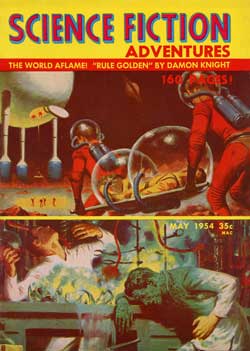Magazine Review: Science Fiction Adventures May 1954 edited by Harry Harrison
This is the final issue of the magazine, one of the Lester del Rey-edited issues of which I reviewed earlier.

We open the issue with “The Science in Science Fiction”, an editorial by Harry Harrison. He’s thrilled about the expansion of types of science used in science fiction stories in the 1950s, but not so keen on “un-science”, stories based on counterfactual or demonstrably false “science.”
“Rule Golden” by Damon Knight is the long piece this time. A newspaper publisher discovers that the top-secret project the U.S. government is hiding is an alien visitor. Being a guy who doesn’t trust the government, he helps the alien escape. This turns out to be a mixed blessing, as the alien came to Earth to infect all humans (and other beings with sufficiently advanced nervous systems) with a form of empathy.
This causes you to feel the pain you inflict on any other living being. Step on their toe, your toe hurts. Starve them, you get hungry. Kill them, you die of the pain. The idea is that humans will of necessity stop hurting each other and live in peace, allowing them to join the galactic culture. Before its release, the alien was spreading the condition relatively slowly, which created the danger that non-infected humans might attack the affected ones in a vain attempt to stop the spread. Now the publisher and alien can hurry around the world to finish the process quickly.
The story is optimistic that this will work out for the better, but handwaves a lot of the possible down sides. The publisher brings up that obligate carnivores going extinct might bring havoc to the ecosystem, though not in so many words. The alien’s response is more or less “that sounds like a you problem.” After all, all the other races of the galaxy have somehow managed.
Early on in the story, the protagonist wonders if the alien visitor is a helpful missionary or a rapacious Columbus–attitudes towards missionaries have changed some in recent decades. Still, some very interesting ideas in here.
“Pinnacle” by Lee J. Fox is about the first mountaineer on the Moon. He’s had an accident, and is about to die. But suddenly there are voices where none should be? Fairly predictable ending.
“Collision Orbit” by K. MacLean takes place in the asteroid belt. A supply salesman has his ship taken over by escaped criminals. He pulls a variant of the old “briar patch” trick on them, and they soon learn what kind of society they’ve joined. Darkly humorous.
“Frankenstein or Friday?” by L. Jerome Stanton is a fact-based piece about the possibility of artificial intelligence. It goes into a great deal of detail about one possible precursor to A.I., the homeostat. (In the current day, the homeostat appears to have been a dead end; but one never knows what will be applicable research in the future.) Long, repetitious and boring because of the latter.
“Amoeba-Hunt” by R.H. Remington takes place in a distant future where monopolistic corporations own almost everything. The new aristocrats, the “Supes” indeed own the very people who work for them, the “Emp” class. It’s possible for an Emp to save up enough to buy himself out of slavery, but then how to make a living and not become indentured again? And what of your family and friends who are still held?
Abner Hudek, first among equals on the independent starship Spartacus, is faced with this dilemma. He’s financially squeezed into capturing a giant amoeba for the arrogant Lord Glanders, who invites himself along on the voyage. It soon becomes clear that even if Hudek and his crew succeed, Glanders has every intention of returning them to slavery. Can the giant amoeba provide a way out?
“The Dissecting Table” by Damon Knight is the book review section, which starts with him listing some underappreciated early novels in the science fiction field. Alas, I have read none of them. In then current material, he liked the expanded version of Ray Bradbury’s Fahrenheit 451 better than the original.
“Rain Check” by Judith Merril has a shapeshifter attempt to join the hunt for itself. Problem is, she can’t take off her clothes. Much sympathy for the poor alien.
“Fanmag” by Charles Lee Riddle is about starting your own fan magazine (it’s going to cost way more than you’ll ever get back) and suggests some fans to contact.
“183rd Congress” by Roy G. Millenson winds up the fiction with a humorous look at what America’s legislature might look like in the distant future. Lower taxes are still a fantasy.
“The Chart Room” is letters to the editor; most about a essay by William Tenn entitled “The Fiction in Science Fiction” which suggested tiny science mistakes don’t ruin a good story.
“Rule Golden” and “Rain Check” are the best stories; the former has been reprinted in several collections of Mr. Knight’s work. This is a decent finish to the run, though of course it nowhere indicates that anyone was aware of that.

